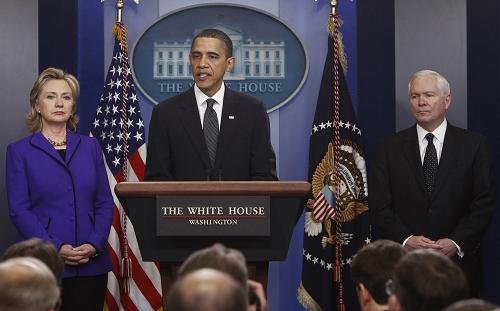U.S., Russia cut nukes by 30%
|
|
|
U.S. President Barack Obama comments on the new START nuclear arms reduction treaty at the White House with Secretary of State Hillary Clinton (L) and Defense Secretary Robert Gates in Washington, March 26, 2010. Obama and Russian President Dmitry Medvedev sealed an agreement on Friday on a landmark nuclear arms reduction treaty and will meet to sign it on April 8 in Prague, the White House said. [Xinhua/Reuters] |
The United States and Russia on Friday finalized a new nuclear disarmament deal to replace the expired Strategic Arms Reduction Treaty (START), agreeing to reduce their deployed nuclear warheads by 30 percent to 1,550.
After a phone call with his Russian counterpart Dmitry Medvedev on Friday morning, U.S. President Barack Obama announced in the White House the new U.S.-Russia nuclear disarmament treaty had finally been hammered out after a year of intense negotiations.
Nuclear stockpiles to be reduced
The two presidents agreed to meet in Prague, the Czech Republic, on April 8 to sign the Treaty between the United States of America and Russia on Measures to Further Reduction and Limitation of Strategic Offensive Arms, or the new START.
Under the treaty, the deployed warheads held by the two super nuclear powers will be reduced to 1,550, about 30 percent lower than a previous nuclear disarmament treaty's limitation.
The number of deployed and non-deployed intercontinental ballistic missile (ICBM) launchers, submarine launched ballistic missile (SLBM) launchers, and heavy bombers equipped for nuclear weapons will be limited to 800, and the number of deployed ICBMs, SLBMs, and heavy bombers equipped for nuclear weapons will be limited to 700.
This means a significant reduction the two countries' nuclear arsenal.
A report released by U.S. State Department last January showed that the number of the deployed warheads were 5,576 by the United States and 3,909 by Russia, and that the number of the deployed launchers were 1,198 by the United States and 814 by Russia.
More importantly, the new treaty set up a transparent verification regime that combines the appropriate elements of the START with new elements tailored to the limitations of the treaty.
Measures under the treaty include on-site inspections and exhibitions, data exchanges and notifications related to strategic offensive arms and facilities covered by the treaty, and provisions to facilitate the use of national technical means for treaty monitoring.
The treaty's duration will be ten years, unless superseded by a subsequent agreement. The parties may agree to extend the treaty for a period of no more than five years. Before the treaty can enter into force, it must be approved by parliaments of the two countries.
Trust and moral to be boosted
At the special press conference, President Obama called the treaty as "the most comprehensive arms control agreement in nearly two decades," saying it will advance the mutual interests between the United States and Russia, and the security and prosperity of the wider world.
In a public speech on April 5, 2009 in Prague, Obama announced his administration was committed to a nuclear-free world, and that U.S. and Russian governments agreed to kick off negotiations over a more ambitious arms control deal to replace the START, which expired on December 5 2009.
Both Obama and Medvedev consider the U.S.-Russian arms control process as a vital step to boost mutual strategic trust, or to " reset" the relationship between the two countries, and to ensure that other countries will work with them together for a nuclear-free world.
 0
0 








Go to Forum >>0 Comments